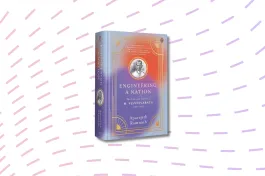Shifts in economic imagination have supplied discursive categories to the imagination of political units. If Lockean ideas on private property legitimised British imperial expansion, the economic drain theory put forward by liberal Indian nationalists was employed by anticolonial thinkers to imagine an independent subcontinent. How have India’s economic reforms of the 1990s and the neo-liberal phase of the global economy shifted ways of imagining the nation-state? Ravinder Kaur’s Brand New Nation answers this question by focusing on state-sponsored advertisement campaigns, where the image of post-reforms India is refashioned for a global market.
Tracing the advertorial project of building ‘capitalist dreamworlds’ and the societal processes that accompany it, Kaur tells us how branding, when extended to nation-states, has altered the way states imagine their own role and their relationship to citizens, but also reinterprets the identity of the nation itself.
Advertising campaigns delegitimised the political commitments and guarantees of the Constitution in favour of the unrestrained reach of the private sector on public resources.
Massive advertising campaigns in the post-reforms period, some funded by public money, facilitated a process of refashioning India from what it was defined to be in the words of the Constitution to what it came to be in the glossy advertorials and the flashy billboards of the post-reform era. Positive and aspirational campaigns — India Shining, Incredible India and Make in India —targeted the rich and the upper middle classes in terms of benefits and the lower classes with the promise of ‘trickle down’ and ‘feel good’. These advertising campaigns delegitimised the political commitments and guarantees of the Constitution in favour of the unrestrained reach of the private sector on public resources.
Other, more critical and negative campaigns called the citizens to action. Ahead of the 2014 elections, the Times of India-hosted Lead/Bleed India campaign fixed the image of the corrupt political world into the psyche of Indians. Kaur argues that these private campaigns articulated old sensibilities in a new diction. In this case, the middle-class beneficiaries of the liberal reforms, impatient with the caste-focused democratisation of the Mandal Commission reforms, felt the need to shift public resources out of the reach of “non-meritocratic” conventional politics tied to goals of welfare.
The aam aadmi was supposed to think of himself not as a job or welfare seeking citizen but rather as an entrepreneur who had internalised the ethic of business.
Through its campaigns, the Indian state advertised its receding from a welfarist and planned economy as a strategy of development. This was presented internationally as India being an investor friendly destination adhering to a culture of risk taking and swift decision making, with light regulation and no bureaucratic culture of slow decision making. (This is an ongoing and now normalised process, most recently seen in the way the present Indian government pitched its deregulation of agrarian markets as reforms to curb corruption, eliminate middle-men, and fix sloppy supply-demand chains, all to usher in development of that sector.) The state was thus refashioned as a facilitator of corporate capital investment.
This messaging was also projected inwards the average citizen or ‘aam aadmi’ (imagined as mostly male) constructed as an ‘investor citizen’. The aam aadmi was supposed to think of himself not as a job or welfare seeking citizen but rather as an entrepreneur who had internalised the ethic of business. By becoming an aspiring consumer, he would also invest by putting money back in the economy.
This citizen was also affectively invested in the ‘India Inc.’ brand: the image of the new India that is smart, modern and ambitious. This was a process that changed the terms of the Hobbesian contract, where the deregulated market fell outside the authority of the state and the investor citizen was in an individual contract with the global market. In this rewriting, citizens had to recalibrate their relationship to the state, with accountability flowing from them to the nation.
The commitment of citizens shifts from the well-defined constitutionalist modern state to a pre-state ambiguous “authentic” personality of the nation.
Kaur tells us how of the processes by which citizens come to not only consent to this new shift but have increasingly come to consume and demand it via their exposure to the re-branding discourse. The first process is the creation of visual affective spectacles and drawing futures. This process entails drawing in two senses: of imagining a capitalist future for the country and of drawing in or persuading investors to invest and citizens to desire it. The act of imagining and persuading fuse in advertising campaigns that announce the arrival of the future in the potential of the present. This is facilitated by a related, second, process where desired statistics and policy recommendations are clothed as the ‘good times’ to manufacture a culture of continuous and compulsory good news. The third process repackages propaganda as a de-politicised campaign to drill into the popular public imagination an image of the sought dream-world as waiting on the horizon.
Branding the nation entails a process of investing the nation with a unique and enduring personality, drawn from an essentialist understanding of culture. This, fourth, process demands a temporal shift in the commitment of the citizen to the nation and a redrawing of the Hobbesian contract. The commitment of citizens shifts from the well-defined constitutionalist modern state to a pre-state ambiguous “authentic” personality of the nation. Finally, this imagined authentic substance of the nation-state becomes the material through which the brand new nation is formed. Branding itself becomes public diplomacy domestically and state diplomacy internationally (Dinnie 2015).
This nation branding draws from the ambiguous symbols of the “pre-Muslim” Indian past, like Yoga and Ayurveda; in the process normalising the exclusion of a religious minority.
Kaur underlines how a brand, trying to carve for itself a niche in the competitive global market, must put on offer an almost transcendental, sublime image of the nation: one that is not economic, yet is precisely what animates the economy. A pristine image of the nation, mixed with the openness to business, has currency in the global market. Cleansed of pressing struggles with inequity, exoticised articulations like those of cultural hospitality, distract the attention of investors away from ‘new India’s’ “negative associations” with its past image of pre-reform mismanagement and social discontent.
The transcendental essence of this dignified national image comes to define the core rationale of political messaging, which becomes very self-conscious especially when directed to an international audience. Such sensitivity tied to the image of the nation, when mixed with nationalism, leads to a narrowing of acceptable articulations about one’s country. Betraying any internal incapacity is seen as, at best, letting down the country or, at worst, being disloyal to it. Citizens will have to be worthy to uphold the image of this new India that has come out of its “dark past” as a poor agrarian country in want of improvement.
To obliterate the imagination of the pre-reform independent state, this nation branding draws from the ambiguous symbols of the “pre-Muslim” Indian past, like Yoga and Ayurveda, in the process normalising the exclusion of a religious minority from the constitutive definition of the nation. As post-colonial commitments to welfarism and a mixed economy are done away with, other ideological commitments of the national freedom movement from where the economic commitments drew, too are reimagined.
Neo-liberal reforms of economy increasingly requires that fault lines between the people be exploited to take attention off its failures.
Kaur’s book underlines how the aims of the global market invariably fit into the cultural nationalism agenda of the Hindu Right. This is explained by the generation of a ‘bond of investment’. Kaur uses the word bond in its dual sense of being a quasi-legal agreement as well as a connection between capital investment and communal discord. This entails an understanding that the investor nation or company must stay silent over domestic failures of liberal commitments.
While the failure of neoliberal market expansion in strengthening liberal values to the country of its import is a sufficiently studied phenomenon (Lee Mudge 2008, Joseph 2007), its need to not only ignore but often manufacture and benefit from civic divisions in society needs more attention. Neo-liberal reforms of economy increasingly require that fault lines between the people be exploited to take attention off its failures (Harmes 2012). Kaur discusses this, even if briefly, to suggest the limits of “happy globalization”.
With liberal reforms failing to bridge the income gap the corporate world required new allies as they sought to move away from constitutional guarantees of social security and personal liberties. This created a need for a more “reform-minded” government that was ready to make peace with the inequalities and not intervene in the reform process. Kaur captures this sense:
“The BJP under Modi transformed itself to a more dependable facilitator of capital thereby wresting the reforms agenda from the Congress party…the change of perception (that Congress was less committed to the reform economic agenda) was blamed on the Congress Party policy of reforms with a human face that allowed concessions such as the Food Security Bill and Right to work schemes to provide subsidized food and 100 days of work, respectively to the poorest citizens” (Pg.154).
The BJP with its willingness to “manage” economic inequalities, presenting itself as most committed to reforms. Its political messaging that equated the good (economic) times with a heady mix of cultural chauvinism would evoke a response in form of the current brand of hypernationalism.
The citizen becomes a consumer of a sectarian political messaging where nationalism was no more limited to aspiring dreamworlds but also protecting it from being “tarnished”.
Kaur argues that the enabling conditions for the rise of Narendra Modi and his authoritarian mode of politics were created by the manufactured consensus about the capitalist dreamworlds and what they demanded in terms of refashioning. The citizen becomes a consumer of a sectarian political messaging where nationalism was no more limited to aspiring dreamworlds but also to protecting it from being “tarnished”. Kaur’s book argues that a need for requital from a sense of being left out of the process of development thus far has been harvested by manufacturing constant good news and incessant public spectacles of “having arrived”, both of which are often devoid of facts.
Brand New Nation skilfully draws the larger connections between rebranding for the foreign investor and what it asks of the internal audience, and how in the process citizens’ political imaginations are reshaped. Its thesis about the citizen seceding from the collective by cultivating a distaste for democratic rituals (p. 186) and equating the worthiness of a nation to the economic productivity of the Volk has considerable import for the country’s political future.










